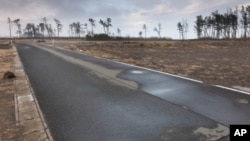The coast of northeastern Japan is still recovering from the earthquake and tsunami that struck a year ago. Two American photographers recently returned to the region to document the changes over the past 12 months. Nick Ut is a Pulitzer-Prize winning photojournalist, and Mark Edward Harris is a fine art photographer who has published books on Japan and other countries.
Photo gallery of M.E. Harris' pictures
Where are the animals?
The scenes of devastation are gone, but photographer Nick Ut says much of the coast that the earthquake and tsunami struck is barren.
“You don't see any animals," said Ut. "I don't even see any birds flying around there. I keep looking in my pictures. I don't see anything.”
Ut has seen devastation before. He was born in Vietnam and covered the Vietnam War. In 1972, he took the famous photo of a nine-year-old girl running in terror from her napalmed village. For that, he earned a Pulitzer Prize. He later worked in Tokyo, Seoul and Hanoi. Today, he's a news photographer based in Los Angeles.
Radiation
Mark Edward Harris has documented the lives of people in North Korea, Iran, and other places not easily accessible to Westerners. He also published a book on Japan's celebrated hot springs.
He says parts of Japan's coast are bleak, especially near the crippled Fukushima Daiichi nuclear plant. Radiation leaks sparked fears across the country, and a 20-kilometer exclusion zone around the plant remains.
Harris teamed up with a group of Japanese and international volunteers. They are feeding abandoned pets in the area.
“And they rescue animals from there, so I went in with them," said Harris. "And it was amazing to see the Geiger counter go up as we got closer.”
Marine life
At a marine park called Aquamarine Fukushima, however, there were signs of hope. More than 90 percent of the fish and shellfish were lost when the power went out, but a pregnant seal was rescued.
“And once the Aquamarine Fukushima was rebuilt and electricity was on, ready to go, they brought the mother and the baby back, and its name is Hope," explained Harris. "And so I did a photograph of a young boy at that tank just being fascinated by Hope. And I think that really is symbolic of where Japan is moving with this tragedy."
Progress
The photographers documented other signs of progress, including a Hawaiian-themed club that recently reopened, replete with hula dancers, and the return of Japanese tourists to Matsushima, a scenic spot on the water. It was spared the worst of the tsunami because it was shielded by the cluster of islands in its bay.
In the coastal city of Sendai, they found residents grateful that the American military helped to get their airport up and running. Harris says it was fully operational within six months of the disaster.
“They did not expect it before the one-year anniversary to being even close to ready, but with the help of the heavy machinery and the technicians from the U.S. military based in Japan, they were able to get it up and running," he added.
While parts of the coastal region where the disaster struck have not recovered, Nick Ut was pleased to see the Tokyo he remembers.
“Traffic, people everywhere," said Ut. "You know, hotels, full of people.”
The two photographers say many in Japan are moving on, even as people on the coast northeast of Tokyo are still coping with the disaster and its aftermath.











